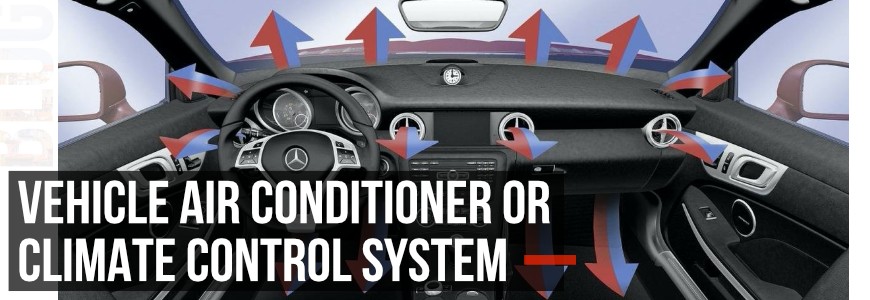
The weather gets hot in summer and an air conditioner or a climate system is the only way to be comfortable on the road. These two systems have significant differences.
Let’s see what the differences are and how to decide between the two systems.
What is the operating principle of a vehicle air conditioner?
The purpose of a vehicle air conditioner is to provide the inflow of air and to cool it. The pre-compressed refrigerant is cooled in the condenser, then purified and condensed. Traveling through the evaporator, the refrigerant desuperheats. The fan sends the cool air from the evaporator into the cabin while Freon is flowing back to the cycle start point.
The air conditioner is on only when the car is started. In the majority of cases, it's the driver who manually controls the power output of the air conditioner. Sometimes, the system is equipped with temperature sensors and switching on of the air conditioner is automatic.
What is the design and the operating principle of a climate control system?
A climate control system creates and maintains a passenger-specific environment inside the cabin, i.e. comfortable temperature and humidity. These parameters can be different in different parts of the cabin. The climate system activates the components of air heating, conditioning, and ventilation systems. This is an ECU that controls the climate system. The sensors outside and inside the vehicle transmit information to the ECU which activates executive units (damper drives and a fan electric motor). The climate system is equipped with the following sensors:
- ambient and inside temperature sensors;
- a whole-sun sensor;
- a sensor of climate system air temperature;
- an evaporator temperature sensor;
- a system pressure sensor;
- a damper potentiometer.
Input sensors read the ambient temperature, then convert the physical parameter into the electric signals and transmit them to the ECU. Output sensors read the temperature of the system-supplied air in the cabin. Their number depends on the climate system type – two- or three-zone climate control.
What is the operating principle of a climate control system?
The driver sets the desired temperature value. The signals from the controller and sensors are broadcasted to the ECU. Following a specific algorithm, the control unit processes information and actuates the necessary components of the system. The system either heats or cools the air. Also, it can dry or humidify it.
The advantages and drawbacks of a climate control system
- Provides comfortable temperature and humidity and maintains them at user-specified level.
- A climate system creates several climate zones in a car. It’s especially important when there are aged people or kids in the cabin.
- The risk of catching a cold is minimum.
- A climate system controls warmth and coolness by switching the air conditioner and heater on and off. It also controls the humidity.
The drawbacks include complex design and thus, costly maintenance and repair.
The advantages and drawbacks of a vehicle air conditioner
The major advantage of any vehicle air conditioner is the simplicity of its design. The fewer electrics and electronics are in the system, the less expensive its maintenance will be. Besides, the vehicles with air conditioners themselves are cheaper than the ones equipped with climate control systems.
The drawbacks:
- changing of the AC operation mode is necessary to keep the cabin temperature comfortable;
- there is a risk of catching a cold;
- specific temperatures cannot be provided for different seating areas.
So.., what choice to make: an air conditioner or a climate system?
These systems are different. An air conditioner is simpler and cheaper. A climate system is more complex, expensive, and multifunctional. Make your choice based on your finances and needs. If everything you need is just a fresh cool air in the car, then the air conditioner will perfectly do for the purpose. If provision of equally comfortable conditions for all the passengers in the cabin is what you want, choose a car with a climate system and prepare to pay more money.
One must bear in mind that there are certain pitfalls here. While everything is quite simple about the air conditioner (you either have it in your car or you haven’t, it is either on or off), things are more complicated when you have a climate system. Real climate control systems are installed in premium class vehicles. The so-called "climate control systems" in the majority of middle-class vehicles are nothing more than a sales pitch that significantly affects the price. The only thing that makes all the difference is the button "AUTO". That is why it needs to be careful about buying a middle-class vehicle equipped with a “climate control system”. After all, there is no point to pay more.



COMMENTS